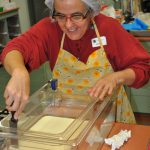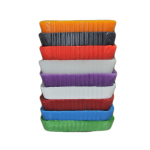These are the cheeses with a white moulded surface and a soft ripened body and a creamy nutty flavour that have been pleasing cheese lovers for centuries. There are so many versions of these cheeses because of the different recipes and techniques used by cheesemakers to make them.
All of these styles of cheese are commonly referred to as bloomy rind in reference to the white velvet coat they have on their surface. They are also called surface ripened cheeses because ripens closest to the rind first then the ripening process works its way to the centre of the cheese. The bloomy white covering comes from the growth of Penicillium Candidum which is a white mould that is sometimes added to the milk and sometimes sprayed onto the surface of the cheese. If a bloomy rind cheese is cut at a young age the cheese near the rind will be soft and creamy but the middle of the cheese will be firm and the cheese will lack full flavour. A more mature cheese will be creamy throughout the cheese with a mushroom and a much stronger flavour.
So what is the main difference between these cheeses?
Level of Creaminess
The body of both Brie and Camembert is very similar, although Brie is denser and a higher level of fat at around 65%. The camembert is around 45% fat. Both cheeses will have soft runny bodies when they are mature. The more dense Brie does take a little longer to ripen.
Raw or Pasteurised
Traditional French Camembert and Brie are both made with raw milk Because of the current laws in Australia these French raw milk cheeses cannot be imported into Australia but the pasteurised versions can be.
Size
A wheel of Brie varies in size from 23cm to 35cm across and about 2cm thick and can weigh between 1.5kg to nearly 3kg in weight. Camembert is about 100m in Diameter, about 3cm thick and weighs around 250g.
Place of Origin
Brie is made in Ile-de-Francewhich is of 1 hours’ drive from the centre of Paris. The two most traditional Bries from this region are Brie de Meauxand Brie de Melun both have Appellation d’origine contrôlée(AOC) status. Camembert is made in Normandy and the famous raw milk version is Camembert de Normandy, also with AOC status.
Brie or Camembert, which came first?
During the French Revolution in 1789 a priest sought refuge from persecution with the family of Marie Harel in the Normandy region near the village of Camembert. The priest came from the Brie region near Paris and provided Marie with the “recipe” of making Brie cheese and a new cheese, Camembert was born.
Why has Camembert and Brie only become well known in the last 50 years?
Across Europe cheeses were very regional and did not travel well due to their soft condition, primitive packaging and the lack of refrigeration transportation. So most cheeses were made and sold locally. With advances in these areas cheeses can now be safely transported around the world
What is a Double or Triple Crème Cheese?
Historically warm cream was added to already high fat fresh milk to make it thicker and creamier and it was then fermented overnight. The slightly acidic curds were added to hoops to drain and the result was a high fat crème Cheese. Add white mould to that cheese and you have a rich buttery and luscious style of cheese known as Double or Triple Cream. They have been referred to as salt and butter because of their extravagant rich creamy flavour. One of the most famous of these cheeses is the triple cream Brillat Savarin.



